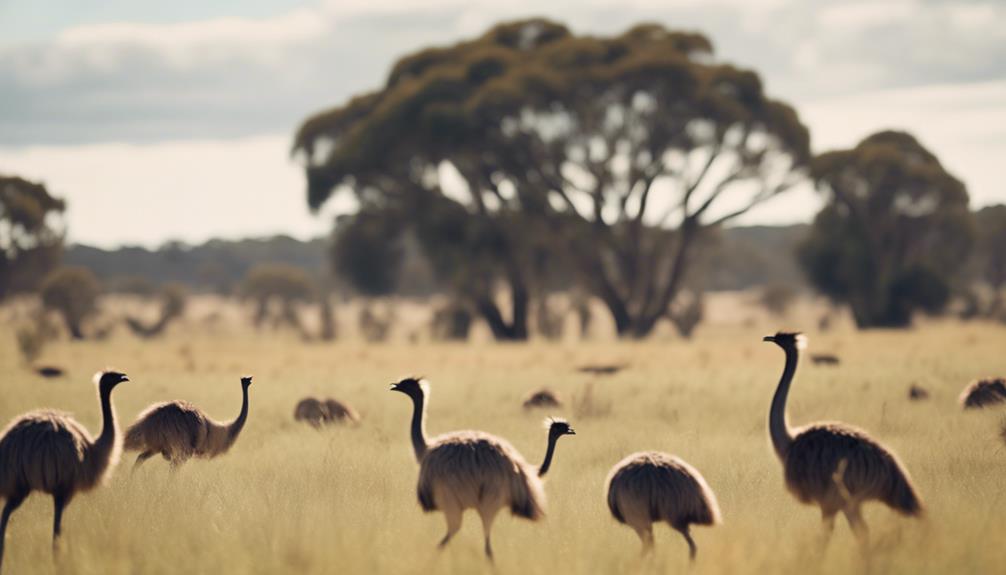
Have you ever considered how emus might influence the delicate balance of ecosystems? Their presence goes beyond mere observation; emus wield a significant impact on various ecological processes, shaping the very fabric of their habitats. As you explore the intricate web of interactions that emus engage in, you may find yourself uncovering a fascinating narrative that speaks to the interconnectedness of all living things within an ecosystem.
Key Takeaways
- Emus aid in seed dispersal, promoting biodiversity.
- Their foraging behavior enhances soil health and nutrient cycling.
- Emus contribute to ecosystem resilience through predator-prey dynamics.
- They control pest populations, aiding in ecosystem balance.
- Emus influence plant diversity and fire regimes, shaping ecosystem dynamics.
Emus' Impact on Seed Dispersal
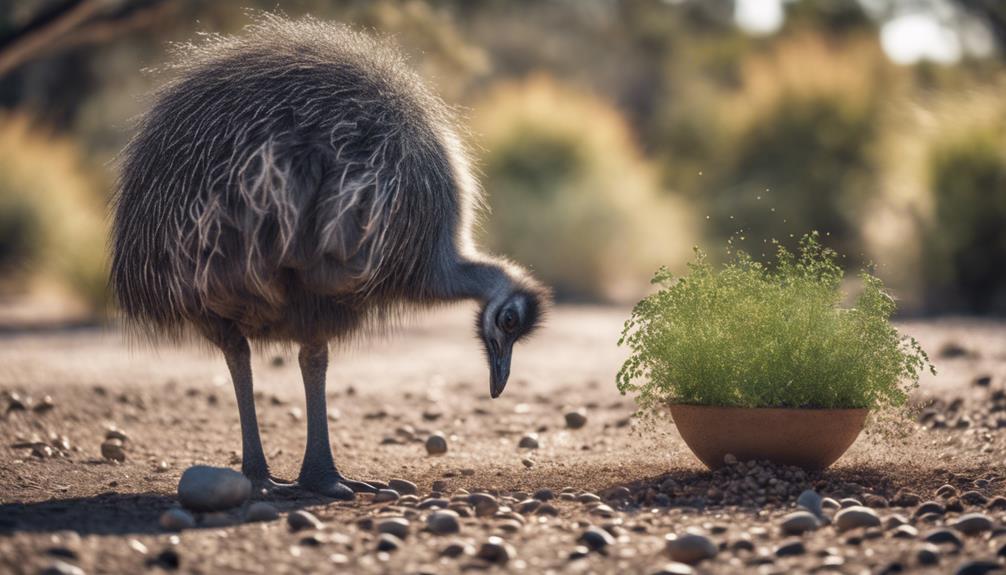
Emus play a crucial role in seed dispersal within their ecosystems through their foraging habits and digestive processes. As they roam their habitats, emus consume a variety of plant seeds. These seeds pass through the emus' digestive system, with some being broken down and digested while others remain intact. This process is essential for the dispersal of seeds across the landscape.
The digestive system of emus acts as a mechanism for breaking down the tough outer coating of seeds, aiding in their germination once deposited onto the ground. Emus are known to travel long distances in search of food, which contributes to the wide dispersal of seeds from various plant species. Through this process, emus help in the colonization of new areas by plants, promoting biodiversity and ecosystem resilience.
Emus' Role in Nutrient Cycling
Playing a crucial role in the cycling of nutrients within ecosystems, emus contribute significantly to the maintenance of ecological balance through their foraging and digestive processes. Emus are known to consume a wide variety of plants, fruits, and insects, which in turn affects the distribution of nutrients in the environment. Through their selective feeding habits, emus help in redistributing nutrients from one area to another, thereby enhancing nutrient cycling within the ecosystem.
| Nutrient Source | Nutrients Consumed by Emus |
|---|---|
| Plants | Nitrogen, Phosphorus, Potassium |
| Fruits | Sugars, Vitamins |
| Insects | Proteins, Fats |
| Seeds | Fiber, Carbohydrates |
| Leaves | Calcium, Magnesium |
Emus play a vital role in nutrient cycling by aiding in the breakdown and decomposition of organic matter through their consumption and subsequent excretion. Their droppings act as natural fertilizers, enriching the soil with essential nutrients that promote plant growth. This process of nutrient cycling facilitated by emus helps sustain the health and productivity of the ecosystem, making them a powerful force in maintaining the ecological balance.
Emus and Soil Health

In the context of ecosystem dynamics, the influence of emus on soil health is a critical factor to consider due to their significant role in nutrient cycling and soil enrichment processes. Emus contribute to soil health in various ways:
- Nutrient Recycling: Emus aid in the breakdown of organic matter through their foraging activities, promoting the release of essential nutrients back into the soil.
- Soil Aeration: Emus' movements, particularly their frequent walking and scratching behavior, help in aerating the soil, enhancing its ability to retain moisture and nutrients.
- Seed Dispersal: Emus play a crucial role in seed dispersal by consuming fruits and then spreading the seeds across different areas through their droppings, aiding in plant diversity.
- Microbial Diversity: Emu droppings contain beneficial microorganisms that contribute to the overall microbial diversity in the soil, promoting its fertility and health.
Understanding the intricate relationship between emus and soil health underscores the importance of conserving these unique birds for maintaining balanced ecosystems.
Emus' Foraging Behavior
Exploring the dietary preferences of emus reveals insightful patterns in their foraging behavior, shedding light on their ecological impact within ecosystems. Emus, as omnivores, exhibit a diverse diet consisting of plants, insects, small vertebrates, and even the occasional pebble for aiding digestion. Their foraging behavior is characterized by a deliberate and methodical approach, utilizing their keen eyesight and strong beaks to detect and consume food sources efficiently.
Emus' feeding habits play a crucial role in shaping the vegetation structure of their habitats. They have a selective feeding behavior, preferring certain plant species over others, which can influence plant diversity and distribution. By consuming seeds and fruits, emus also contribute to seed dispersal, aiding in the regeneration of plant populations.
Moreover, emus' foraging behavior can impact nutrient cycling within ecosystems. Through their consumption of various food items, emus play a part in transferring nutrients across different trophic levels, ultimately influencing the overall productivity and dynamics of the ecosystem. Understanding and appreciating the intricacies of emus' foraging behavior is essential for comprehending their significance in ecosystem functioning.
Emus' Predation Effects
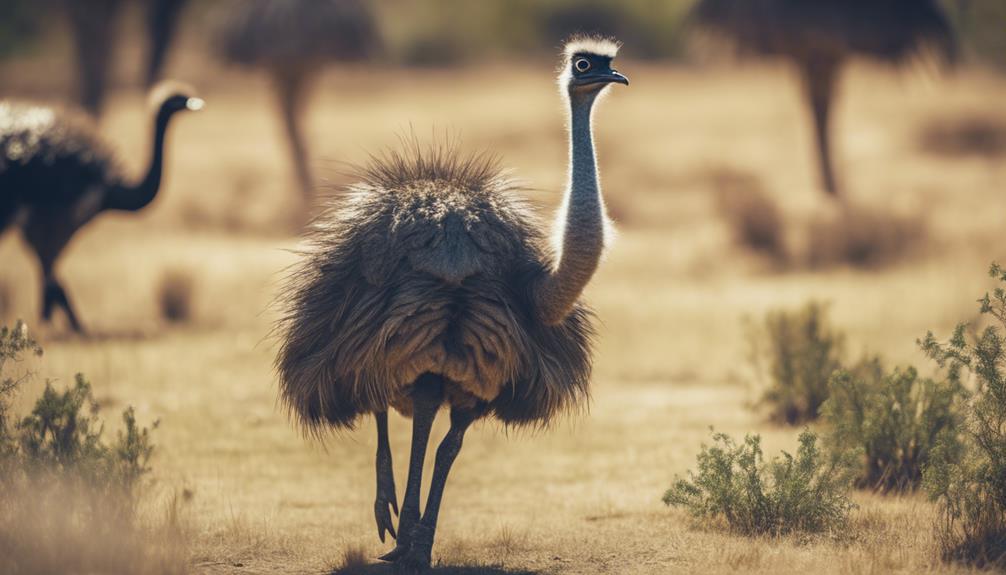
Emus' predation effects on local fauna and flora are a critical aspect of their ecological impact within ecosystems. These effects play a vital role in shaping the dynamics of wildlife and vegetation in their habitats.
- Prey Population Dynamics: Emus primarily feed on insects, small mammals, reptiles, and occasionally birds. By preying on these animals, emus help control their populations, preventing overgrazing or overpopulation that could disrupt the balance within the ecosystem.
- Vegetation Impact: Emus also consume a variety of plants, influencing the distribution and abundance of different plant species. Their feeding behavior can lead to changes in plant composition, affecting the structure of the vegetation in their environment.
- Biodiversity Maintenance: Through their predation effects, emus contribute to maintaining biodiversity by regulating the populations of both prey species and plants. This helps promote a more diverse and stable ecosystem.
- Ecological Balance: Emus act as top predators in their habitat, playing a crucial role in the food chain. Their predation effects have ripple effects throughout the ecosystem, influencing the interactions between various species and maintaining a harmonious balance within the environment.
Emus and Plant Diversity
Emus play a significant role in influencing plant diversity within their ecosystems through their feeding behavior and interactions with various plant species. As herbivores, emus consume a wide array of plant species, impacting the abundance and distribution of vegetation. Their selective feeding habits can lead to changes in plant composition, favoring certain species over others. This selective pressure can influence the competitive dynamics among plant populations, ultimately shaping the overall plant diversity within the ecosystem.
Moreover, emus also contribute to plant diversity through their role as seed dispersers. By consuming fruits and seeds from different plant species, emus aid in the dispersal of seeds across the landscape. This dispersal mechanism helps plants colonize new habitats, increasing the overall diversity of plant species present in the ecosystem.
Emus' Habitat Modification
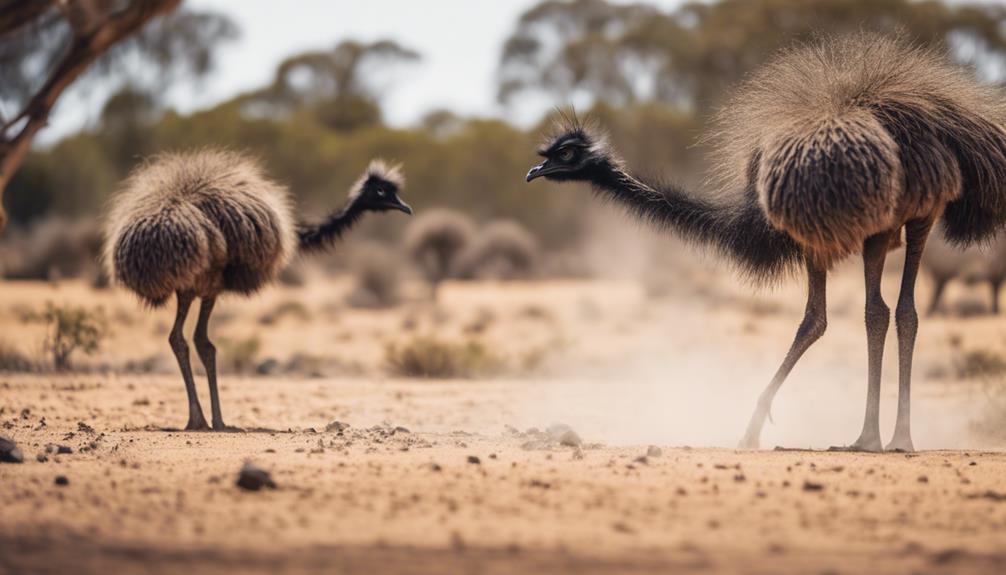
Within their ecosystems, emus actively modify habitats through their foraging activities, impacting the vegetation structure and composition. Emus, as large herbivores, play a crucial role in shaping the landscape around them. Here are four key ways in which emus' habitat modification influences their environment:
- Vegetation Trampling: Emus' movement through the landscape can lead to the trampling of vegetation, altering the physical structure of plant communities.
- Seed Dispersal: Emus consume a variety of plant seeds, transporting them across distances in their digestive system and depositing them in new locations, influencing plant distribution patterns.
- Vegetation Consumption: Emus selectively feed on different plant species, affecting the abundance and distribution of various plants within their habitats.
- Microhabitat Creation: By creating disturbances through foraging, emus can create microhabitats that benefit other species, promoting biodiversity within the ecosystem.
Emus' habitat modification activities showcase their significant impact on ecosystem dynamics and highlight their role as ecosystem engineers.
Emus and Pest Control
In considering pest control strategies within ecosystems, the impact of emus on pest populations becomes a crucial aspect to examine. Emus, as large flightless birds, play a significant role in controlling pest populations due to their feeding habits. These birds are known to consume a variety of insects, small mammals, and even plants that may be classified as pests within their habitat. Emus are particularly effective in controlling insect populations, such as grasshoppers and beetles, which can have detrimental effects on vegetation if left uncontrolled. By preying on these pests, emus help maintain a balance within the ecosystem, preventing outbreaks that could lead to widespread damage.
Additionally, emus contribute to pest control through their foraging behavior, which can disturb and expose pests hiding in the soil or vegetation. This disturbance can make pests more vulnerable to natural predators or environmental conditions, further aiding in pest management. Overall, the presence of emus in ecosystems can have a positive impact on pest control, promoting a healthier and more balanced environment.
Emus and Fire Regimes
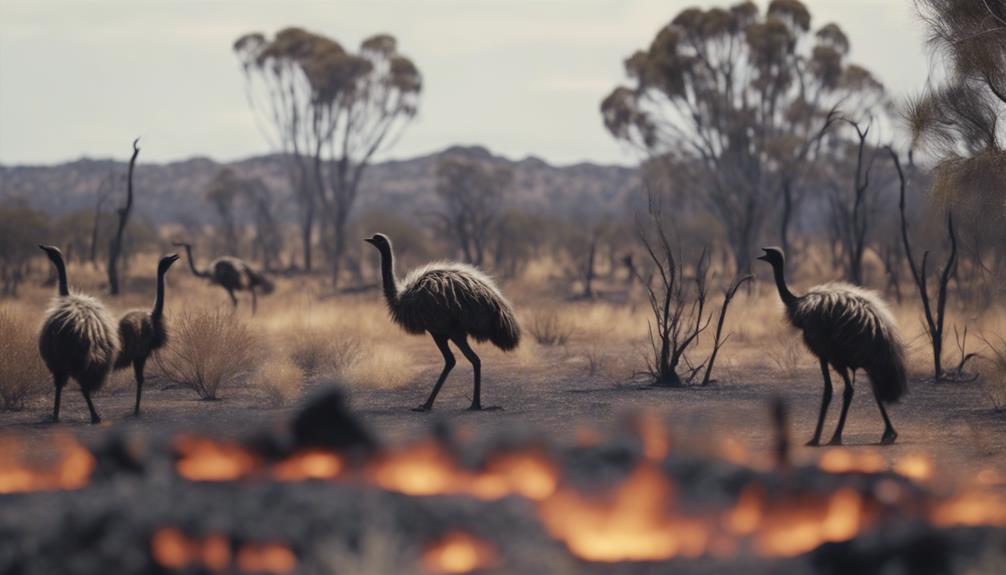
When considering the impact of emus on fire regimes within ecosystems, their foraging behavior and movement patterns play a crucial role in shaping the frequency and intensity of wildfires. Emus, as large flightless birds, interact with their environment in ways that can either exacerbate or mitigate fire risks. Here are four key points to deepen your understanding:
- Foraging Behavior: Emus are known to consume a variety of vegetation types, including grasses and shrubs. By selectively feeding on certain plant species, they can influence fuel loads and modify the flammability of the landscape.
- Movement Patterns: Emus cover vast distances in search of food and water, which can lead to the dispersal of seeds and create a mosaic of vegetation patches. This patchiness can act as natural firebreaks, limiting the spread of wildfires.
- Nesting Habits: Emus build large, conspicuous nests that are often located in open areas. These nests, due to their size and structure, can serve as focal points for fire ignition or spread.
- Response to Fire: Emus exhibit varying responses to fires, with some individuals fleeing while others may be attracted to the aftermath for opportunistic foraging on post-fire regrowth. This behavior can influence fire recovery trajectories in ecosystems.
Understanding the intricate interactions between emus and fire regimes is essential for effective ecosystem management and conservation efforts.
Emus' Influence on Wildlife
Emus' impact on wildlife populations can be observed through their interactions with other species and their role in shaping ecosystem dynamics. These large flightless birds are known to influence various aspects of wildlife through their foraging behavior, habitat modifications, and interactions with predators and prey species. Here is a table illustrating some key points on how emus influence wildlife in ecosystems:
| Emus' Influence on Wildlife | Description |
|---|---|
| Foraging Behavior | Emus consume a variety of plants, insects, and small animals, impacting the availability of resources for other herbivores and predators. |
| Habitat Modifications | Emus create pathways and disturbances in their environment, affecting the distribution and abundance of species in their habitat. |
| Predator-Prey Dynamics | Emus can serve as both prey and predators, influencing the population dynamics of species they interact with. |
| Competition with Other Species | Emus compete for resources with other herbivores, potentially leading to shifts in species composition and abundance. |
Emus play a significant role in shaping wildlife populations and community structures within ecosystems, showcasing their power to influence the balance of nature.
Emus and Ecosystem Resilience

Among the factors influencing ecosystem resilience, the presence of emus has been shown to play a crucial role in maintaining the stability and adaptability of natural systems. Emus contribute significantly to ecosystem resilience through various mechanisms:
- Seed Dispersal: Emus consume a wide variety of plant seeds and fruits, aiding in the dispersal of seeds across different areas. This helps in the regeneration of plant species and promotes biodiversity.
- Vegetation Control: Emus are selective grazers, preferring certain plant species over others. By controlling vegetation growth through their feeding habits, emus help prevent the dominance of a single plant species, thus maintaining a balanced ecosystem.
- Nutrient Cycling: Emus excrete nutrient-rich feces that enhance soil fertility. This nutrient cycling process promotes plant growth and overall ecosystem health.
- Predator-Prey Dynamics: Emus serve as both predator and prey in their ecosystems, influencing the population dynamics of other species. This balanced interaction contributes to the resilience of the entire ecosystem.
Emus' Contribution to Biodiversity
The diversity of flora and fauna in ecosystems is significantly influenced by the presence of emus. Emus play a crucial role in maintaining biodiversity through their foraging habits. As omnivores, emus consume a wide variety of plants, fruits, seeds, and insects, which helps control the population of certain plant species and insects while spreading seeds of different plant species across the landscape. This foraging behavior creates a mosaic of habitats, promoting the growth of diverse plant communities and providing a rich food source for other herbivores and insects.
Moreover, emus contribute to biodiversity through their interactions with other species. By dispersing seeds in their droppings and creating disturbances in the soil while foraging, emus create microhabitats that support the growth of different plant species and provide shelter for small animals. Additionally, emus serve as prey for predators, maintaining a balanced ecosystem where each species plays a vital role in the intricate web of life. Through their unique foraging behaviors and interactions with other organisms, emus enhance the biodiversity of ecosystems, ensuring their resilience and sustainability.
Frequently Asked Questions
Do Emus Have Any Cultural Significance in Indigenous Communities?
Emus hold deep cultural significance in many indigenous communities. They are revered for their symbolism, stories, and traditional practices. Emus are integral to ceremonies, spiritual beliefs, and the preservation of cultural heritage among indigenous groups.
How Do Emus Contribute to the Local Economy?
Emus contribute to the local economy through ecotourism, meat production, and feather trade. Their presence attracts visitors, their meat is consumed by locals and exported, and their feathers are used for various products.
Are Emus Affected by Climate Change and Habitat Loss?
Emus are indeed impacted by climate change and habitat loss. These changes disrupt their natural environments, affecting breeding grounds and food sources. As a result, emu populations may decline, highlighting the urgency of conservation efforts.
Can Emus Coexist With Livestock on Grazing Lands?
You might think emus and livestock on grazing lands could be best buds, but reality says otherwise. Emus bring unique dynamics that clash with livestock operations, creating challenges for coexistence on these shared habitats.
Do Emus Have Any Known Predators in the Ecosystem?
Emus, as apex predators in their habitats, face few natural enemies. Threats to emus are limited, primarily due to their size, speed, and defensive capabilities. These factors contribute to the emu's position as a dominant species in the ecosystem.
Conclusion
As you reflect on the intricate web of interactions within ecosystems, consider the pivotal role that emus play in maintaining balance and resilience. Their impact on seed dispersal, nutrient cycling, soil health, and biodiversity is undeniable.
However, there's one crucial aspect of emus' influence that has yet to be fully understood. Stay tuned for future research that may uncover the hidden depths of emus' contribution to ecosystem dynamics.
The intrigue surrounding these fascinating birds continues to grow.




